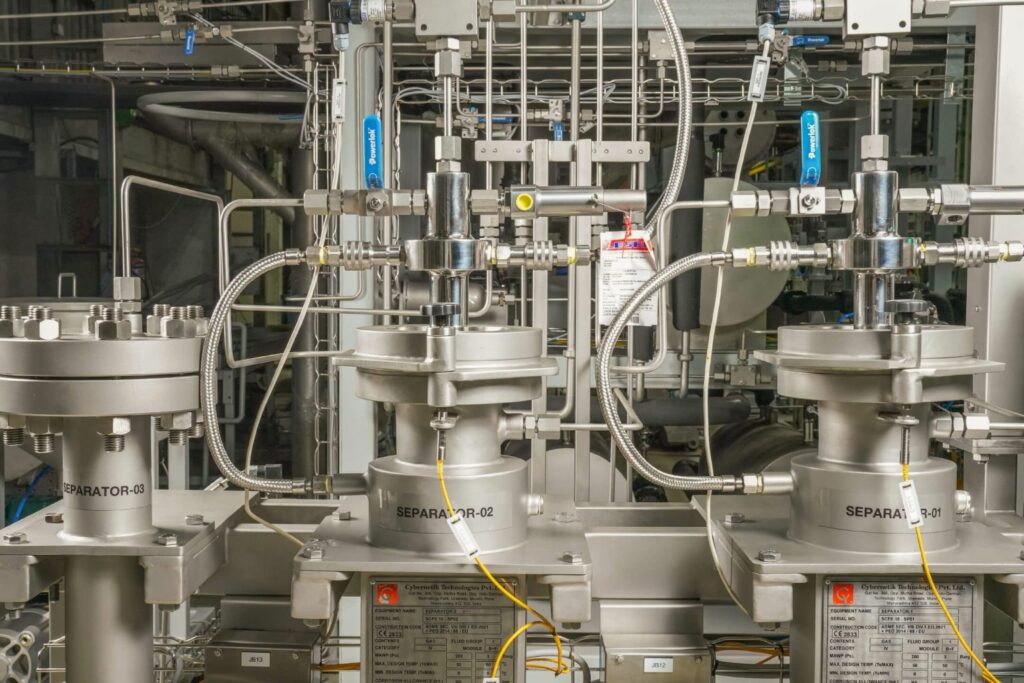Supercritical CO₂ extraction has become a cornerstone in producing high-purity extracts for industries like pharmaceuticals, nutraceuticals, and botanicals, leveraging carbon dioxide’s unique properties above its critical point of 31.1°C and 73.9 bar. In this state, CO₂ combines liquid-like solvency with gas-like diffusivity, making it an ideal solvent for extracting compounds like cannabinoids, terpenes, and essential oils without toxic residues. The Level 2 supercritical CO₂ extractor from Buffalo Extraction Systems, equipped with 25-liter vessels in 2 or 3-unit configurations, is designed for mid-scale operations, processing milled biomass in a closed loop CO₂ extractor. A defining safety advantage of this co2 extraction machine is CO₂’s non-flammable nature, which mitigates risks inherent in alternative solvent-based systems. Integrated with features like the SCADA Systems for recipe-based control, Series Extractor mode, and a co-solvent pump, Level 2 systems prioritize safety while maintaining efficiency. For those evaluating a co2 extraction machine for sale, this non-flammable property is a critical factor, especially when considering the supercritical CO₂ extraction machine price and operational safety. Below, we explore why CO₂’s non-flammability is a game-changer for safety in supercritical fluid extraction equipment.
The Mechanics of Level 2 Supercritical CO₂ Extraction
Level 2 co2 extraction equipment operates in batch mode, handling organic materials in vessels rated for 350-650 bar (5000-9500 PSI) and temperatures of 70-110°C (158-230°F). A high-pressure pump (150-350 LPH flow rate) compresses CO₂ to its supercritical state, where it permeates biomass to dissolve target compounds. The solvent stream then flows to dual separators with independent pressure controls, fractionating extracts—e.g., terpenes in one, heavier oils in another. The CO₂ Feeding & Recovery System recycles CO₂ by condensing it into liquid form, ensuring a sustainable, closed-loop process, as highlighted on Buffalo’s site. Certifications like CE, ASME, GMP, and PED underscore the system’s compliance with rigorous safety standards.
Unlike hydrocarbon solvents (e.g., butane or propane), which are highly flammable, CO₂ poses no ignition risk, even under high-pressure conditions. This is critical in a c02 extraction machine, where components like pumps, heaters, and valves operate near extreme pressures and temperatures. The non-flammable nature of CO₂, combined with proprietary features like superior sealing technology and automatic changeover valves, ensures a safer operational environment, reducing hazards for personnel and facilities.
Why CO₂’s Non-Flammability Enhances Safety
The non-flammable property of CO₂ is a linchpin for safety in Level 2 co2 extraction systems, offering distinct advantages over flammable solvent alternatives. Here’s how it transforms safety protocols:
1. Eliminating Fire and Explosion Risks
Hydrocarbon-based extraction systems, common in cannabis or essential oil processing, carry inherent fire and explosion risks due to their low flash points. A single spark or equipment fault in a hydrocarbon setup can ignite volatile vapors, endangering operators and facilities. In contrast, CO₂ in a supercritical CO₂ extraction machine is non-flammable, as noted on Buffalo’s site: “non-flammable” is a core benefit. This eliminates the need for explosion-proof infrastructure, such as Class 1 Division 1-rated rooms, which significantly increases setup costs for hydrocarbon systems.
In a Level 2 co2 extract machine, high-pressure operations (up to 650 bar) are routine, yet CO₂’s inert nature ensures no combustion risk, even during pressure relief or maintenance. The system’s unique extractor closure design facilitates rapid batch changeovers without exposing operators to flammable gases, while proprietary changeover valves maintain isolation at high pressures, preventing leaks. This makes the system ideal for densely packed facilities where fire hazards could disrupt operations or violate safety codes.
2. Safer Operation with Co-Solvent Integration
Level 2 systems include a co-solvent pump to enhance extraction of polar compounds, often using ethanol in small volumes. While ethanol is flammable, its use in trace amounts (typically 5-15% of CO₂ flow) within a CO₂-dominated stream minimizes ignition risks. The non-flammable CO₂ acts as a diluent, reducing the flammability of the hybrid solvent compared to ethanol-only systems. Buffalo’s site emphasizes “precise pressure control” and “consistent flow control,” which ensure stable co-solvent delivery, preventing unsafe accumulations.
The SCADA System enhances this safety by enabling remote monitoring of pump and valve states, alerting operators to anomalies like pressure spikes or flow disruptions. This reduces the need for personnel to interact directly with high-pressure components, further lowering exposure to potential hazards in a co2 extraction system. For operators, this means safer handling of diverse feedstocks, from hemp to spices, without compromising on extract variety.
3. Compliance and Reduced Operational Liabilities
Regulatory compliance is paramount in industries using supercritical fluid extraction equipment, particularly for GMP-certified products. CO₂’s non-flammable, non-toxic nature aligns with stringent safety standards like SIL-3 and cGMP, as listed on Buffalo’s site. Unlike hydrocarbon systems, which require extensive ventilation and fire suppression systems, a closed loop CO₂ extractor simplifies facility design, reducing capital expenditure and ongoing compliance costs.
The system’s “reusability of CO2” and “non-toxic” properties minimize environmental and health risks, avoiding costly spill containment or disposal protocols associated with flammable solvents. The SCADA Systems predictive maintenance features monitor seal integrity and pump performance, preempting failures that could lead to safety incidents. For facilities evaluating co2 extraction machine price points, these factors lower long-term liabilities, enhancing ROI by avoiding fines, downtime, or retrofitting for safety compliance.
Broader Implications for Industry Safety
CO₂’s non-flammability positions Level 2 systems as a safer alternative in the extraction landscape, particularly for mid-scale operations scaling from R&D to production. It eliminates the need for hazardous material handling protocols, simplifies training, and supports safer multi-vessel operations in Series mode, where automatic valves ensure seamless CO₂ flow. The special separator design for resinous or low-viscosity extracts further reduces operator exposure to volatile residues.
For those researching a supercritical CO₂ extraction machine for sale, CO₂’s safety profile is a strategic advantage, reducing insurance costs and enabling flexible facility layouts. As regulations tighten on solvent safety, this feature future-proofs investments, ensuring compliance without compromising efficiency. In essence, the non-flammable nature of CO₂ transforms a co2 extraction machine into a secure, sustainable platform, safeguarding both people and profits.




